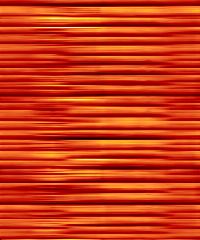Previous Projects
Nearly all of the observed behavior in this system features spatially uniform oscillations due to a global coupling between all parts of the catalyst. This coupling is likely due to diffusion of either concentration or temperature gradients either through the platinum or the gas surrounding the catalyst. We have performed a series of tests in order to determine which coupling mechanism best describes the observed behavior.

| |
In the space-time plot above, the temperature of the catalyst is plotted as a function of position around the ring and time. In the figure, black represents cooler temperatures and yellow represents hotter temperatures. The platinum has been physically split into two pieces by cutting the thin film. The location of the cuts are indicated by the arrows. Despite this, the oscillations are spatially synchronized, indicating that surface-based mechanisms are not responsible for spatial coupling.

| |
Preventing gas phase communication by installing a physical barrier splitting the gas stream into two parts leads to a breakdown of the coupling as each half of the ring oscillates independently of the other. The barrier divided the catalyst as indicated by the arrows. The remaining question is whether this coupling is through the diffusion of temperature or concentration gradients.

| |
Finally, the two hot spots in this space-time plot are localized temperature perturbations. As these perturbations failed to induce a transition, we conclude that gas-phase concentration diffusion is the primary coupling mechanism in this system.
|
| S. Y. Yamamoto, C. M. Surko, and M. B. Maple, J. Chem. Phys. 103 (1995), pp. 8209-15. |